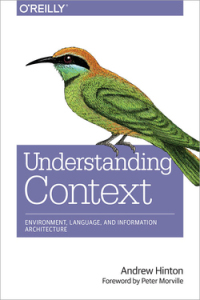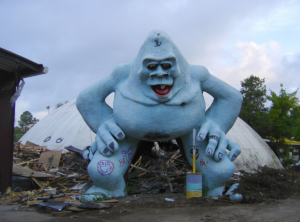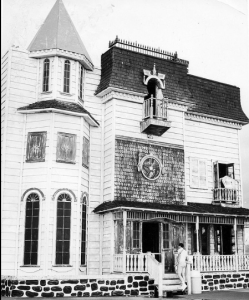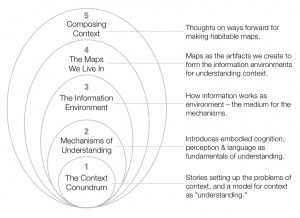Andrea Resmini and co-organizers of the upcoming workshop on Architectures of Meaning (part of the Pervasive Computing conference at Newcastle University in the UK) asked me to participate this year. I’m not able to be there in person, unfortunately, but plan to join remotely. What follows is the “paper” I’m presenting. It’s not a fully fledged academic piece of writing — more like a practitioner-theorist missive.
I’m sharing it here because others may be curious, and it’s also the best summary I’ve done to date of the ideas in the book I’m writing on IA and designing context.
This is a straight dump from MS Word (with a few tweaks). Caveat emptor.
Information Architecture and the Composition of Context
Andrew Hinton
Final Draft for Architectures of Meaning Workshop
June 18, 2012
Introduction
We lack fully articulated models for context, yet information architecture is especially significant in how context is created, changed or communicated in digital-based information environments. This thesis proposes some principles, models and foundational theories for the beginnings of a framework of context and proposes composition as a rubric for tying these ideas together into IA practice.
The thesis follows a line of reasoning thus:
Context is constructed.
There’s a deep and wide intellectual history around the topic of context. Suffice it to say that there are many layers and threads in the ongoing conversation among experts on the subject. Even though all those threads don’t agree on every point, they add up to some generally accepted ideas, such as:
- Context is both internal and external. Our minds and bodies determine and influence how we perceive reality, and that internal experience is affected by external objects and interactions. Both affect one another to the point where the distinction between “inner” and “outer” is almost entirely academic.
- Context has both stable and fluid characteristics. Certainly there are some elements of our lives that are stable enough to be considered “persistent.” But our interactions with (and understanding of) those elements still can make them mean something very different to us from moment to moment. Context exists along an undulating spectrum between those poles.
- Context is social. Our experience of context emerges from a cognitive history as social beings, with mental models, languages, customs — really pretty much everything — originating from our interactions with others of our kind.
Context is not so simple as “object A is in surrounding circumstance X” — the roles are interchangeable and interdependent. This is why context is so hard to get our hands around as a topic.
(In particular, I’m leaning on the work of Paul Dourish, Bonnie Nardi, Jean Lave, Marcia Bates and Lucy Suchman.)
Context is about understanding.
This phenomenological & post-modern frame for context necessarily complicates the topic — not to point out these complexities would keep us from getting at a real comprehension of how context works.
Still, it can be helpful to have a simple model to use as a compass in this Escher-like landscape. Hence, the following:
Context is conventionally defined as the interplay between several elements:
- Situation: the circumstances that comprise the setting (place, time, surroundings, actions, etc.). The concept of “place” figures very heavily here.
- Subject (Event/Person/Statement/Idea): the thing that is in the situation, and that is the subject of the attempted understanding.
- Understanding: an apprehension of the true nature of the subject, through awareness and/or comprehension of the surrounding situation.
- Agent: the individual who is trying to understand the subject and situation (this element is implied in most definitions, rather than called out explicitly).
Context, then, is principally about understanding. There is no need for discussion of context unless someone (agent) is trying to understand a subject in a given situation. That is, context does not exist out in the world as a thing in itself. It emerges from the act of seeking to understand.
This also forms a useful, simple model for talking about context and parsing the elements in a given scenario. However, it gets more complicated due to the ideas, mentioned above, about how context is constructed. Just a few of the wrinkles that come to light:
- There can be multiple subjects, even if we understand them by focusing on (or foregrounding) one at a time.
- The subject is also always part of the situation, and any of the circumstances could easily be one or more subjects.
- In fact, in order to understand the situation, it has to be focused on as a subject in its own right.
- All of these elements affect one another.
- Importantly, the subject may be the agent. And there can be multiple agents, where another observer-agent may be able to understand the situation better than the subject-agent, because the subject-agent “can’t see the forest for the trees.” In design for a “user” this is an especially important point, because the user is both agent and subject — a person trying to understand and even control his or her own context.
As you can see, what looks like a simple grammar of what makes context can actually expose a lot of complexity. But this simple model of elements helps us at least start to have a framework for picking apart scenarios to figure out who is perceiving what, which elements are affecting others, and where understanding is and isn’t happening.
In order to unravel this massive tapestry, we have to grab a thread; a good one to grab is what we mean by “understanding.”
And that means we have to understand cognition, which is the engine we use for understanding much of anything.
Read the rest of this entry »







